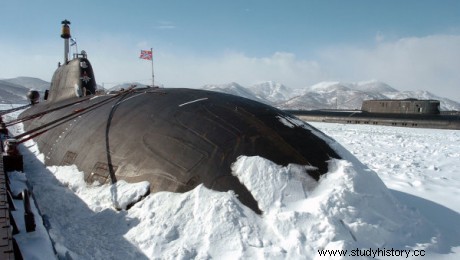
The submarine incident off the Kola Peninsula is the collision between the US Navy nuclear submarine USS Grayling and the Russian Navy nuclear ballistic missile submarine K-407 Novomoskovsk 100 miles away north of the Russian naval base in Severomorsk on March 20, 1993. The incident takes place as the American submarine, which was following the Russian building, temporarily loses track of the Novomoskovsk. When the Grayling reacquired the echo from the Novomoskovsk, the short distance of only half a mile made collision inevitable. The incident takes place just a week before the summit organized between US President Bill Clinton and the President of the Russian Federation, Boris Yeltsin.
Despite the end of the Cold War and the fall of the Soviet Union in 1991, the United States government instructed the US Navy to continue to conduct tight surveillance of Russian nuclear submarine bases in order to monitor their activity, and in particular that linked to strategic assets that remained under Russian control. This type of underwater surveillance is officially known as Operation Holy Stone and Operation Pinnacle or “Bollard” in submariner jargon. Intelligence-gathering included tapping Russian submarine communications cables, recording sounds made by former Soviet submarines (still in operation), and observing sea-to-ground missile tests conducted since then. submarines.
On February 11, 1992, the nuclear attack submarine USS Baton Rouge collided with the Russian nuclear submarine K-276 Kostroma off Severomorsk. The supposed mission of the Baton Rouge is then to deposit or recover on the seabed material allowing the collection of intelligence. The American press claims that the submarine was monitoring wireless communications between various Russian bases, but the Russians and other sources claim that the two vessels were engaged in a "game of cat and mouse"
According to some sources, the Baton Rouge was removed from the United States Navy lists following the incident due to the high cost of repairing the damaged hull, as well as the need to replace its nuclear fuel at the same time. /P>
The Collision
The Novomoskovsk, commanded by Captain 1st Rank Andrei Bulgarkov was on combat training exercises 105 nautical miles (194 km) north of Murmansk. Having reached the northern end of the zone defined for its exercises, the Novomoskovsk turned around at a speed of between 16 and 18 knots (30 to 33 km/h). Twenty-five minutes later, when it was 74 meters deep, the Novomoskovsk felt an impact followed by a screeching sound. In the seconds that follow, its sonar locates noises coming from a foreign submarine cruising in the immediate vicinity. Before leaving the area, the Grayling made sure that the Russian submarine had not suffered significant damage.
An investigation revealed that the Grayling had followed the positions of the Novomoskovsk from a position between 155 and 165 degrees to port and from a distance of between 11 and 13 km (59 to 70 nautical miles). The Grayling lost track of the Novomoskovsk when the latter changed course 180 degrees. To reacquire her target, the Grayling accelerated towards the point of loss of contact at a speed of 8 to 15 knots (15 to 28 km/h).
Breaking waves created in the shallow waters of the Barents Sea generate sonic clutter, so that when two submarines approach each other head-on, each only detects the other's presence when the distance between the two is now only a few hundred meters. The Grayling's passive sonar detects the Novomoskovsk at a distance of about one kilometer (0.54 nautical miles). With the distance closing in and the Grayling's Combat Information Center taking time to decide what was the best option to avoid the collision, the Grayling's commanding officer, Captain Richard Self, attempted to change course and surface, but this attempt was made impossible by Grayling's momentum. The Grayling collided with the upper structure of the Novomoskovsk, which emerged from the collision with a major scratch on her starboard bow. The American submarine must also deplore minor damage. The American submarine was repaired and remained in service until 1997, when it was finally decommissioned. Novomoskovsk will also return to service, and after a total refit, she is scheduled to remain in service with the Russian Navy until 2020.
Political consequences
The second collision between American and Russian submarines in just over a year has sparked an avalanche of angry reactions, both inside the Clinton administration and in Russia. The news confirming that the US Navy was maintaining surveillance over Russian ports and bases comes just a week before a planned summit between the two countries' presidents. At that time, the US government was trying to improve relations with Moscow, particularly supporting the reforms led by Yeltsin. During the summit, which was taking place in Canada, Clinton promises that he would call for an investigation not only into the incident, but also into the politicians “whose incident happened as an unintended consequence.”
Clinton's statement caused concern within the US Navy's senior command, but after a meeting of top Navy commanders, as well as new National Security Adviser Anthony Lake, the submarine force received authorization to continue its activities in the Barents Sea, but on a smaller scale. This incident also sparked a major effort to limit operating procedures and an effort to improve training for submarine commanding officers.
